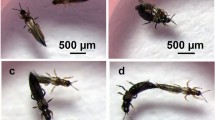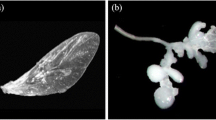Abstract
The body sizes of individuals of the choosing and chosen sexes in a mate choice may affect sequential mating of females. We examined the effects of the body sizes of females and their mates on attributes of female first mating, and the effects of body sizes of females and their previous and potential future mates on female remating in the adzuki bean beetle, Callosobruchus chinensis. Large- and small-sized adults were derived from larvae reared under conditions of low and high density in a bean, respectively. The speed of first mating of large females was not affected by the size of courting males, whereas small females initiated mating more rapidly when courted by small males. The remating probability of large females was not affected by first male size, whereas small females that mated first with smaller males were more likely to remate. These data suggest that pre- and post-copulatory female choices for male size depend on the female’s size, and the small females might be more willing to copulate with smaller males but prefer larger males to sire their offspring after copulation. A possible explanation for this preference is that small females may suffer greater harm from copulating with larger males.

Similar content being viewed by others
References
Aisenberg A (2009) Male performance and body size affect female re-mating occurrence in the orb-web spider Leucauge mariana (Araneae, Tetragnathidae). Ethology 115:1127–1136
Andersson M (1994) Sexual selection. Princeton University Press, Princeton
Arnqvist G, Rowe L (2005) Sexual conflict. Princeton University Press, Princeton
Bergström J, Wiklund C, Kaitala A (2002) Natural variation in female mating frequency in a polyandrous butterfly: effects of size and age. Anim Behav 64:49–54
Colgoni A, Vamosi SM (2006) Sexual dimorphism and allometry in two seed beetles (Coleoptera: Bruchidae). Entomol Sci 9:171–179
Crean CS, Gilburn AS (1998) Sexual selection as a side effect of sexual conflict in the seaweed fly, Coelopa ursina (Diptera: Coelopidae). Anim Behav 56:1405–1410
Crudgington HS, Siva-Jothy MT (2000) Genital damage, kicking and early death. Nature 407:855–856
Darwin C (1871) The descent of man and selection in relation to sex. John Murray, London
Fisher HS, Rosenthal GG (2006) Hungry females show stronger mating preferences. Behav Ecol 17:979–981
Fox CW, Moya-Laraño J (2009) Diet affects female mating behavior in a seed-feeding beetle. Physiol Entomol 34:370–378
Fox CW, Hickman DL, Raleigh EL, Mousseau TA (1995) Paternal investment in a seed beetle (Coleoptera: Bruchidae): influence of male size, age, and mating history. Ann Entomol Soc Am 88:101–103
Gabor CR, Halliday TR (1997) Sequential mate choice by multiple mating smooth newts: females become more choosy. Behav Ecol 8:162–166
Gay L, Brown E, Tregenza T, Pincheira-Donoso D, Eady PE, Vasudev R, Hunt J, Hosken DJ (2011) The genetic architecture of sexual conflict: male harm and female resistance in Callosobruchus maculatus. J Evol Biol 24:449–456
Harano T, Miyatake T (2005) Heritable variation in polyandry in Callosobruchus chinensis. Anim Behav 70:299–304
Harano T, Miyatake T (2007) Interpopulation variation in female remating is attributable to female and male effects in Callosobruchus chinensis. J Ethol 25:49–55
Harano T, Yasui Y, Miyatake T (2006) Direct effects of polyandry on female fitness in Callosobruchus chinensis. Anim Behav 71:539–548
Harano T, Nakamoto Y, Miyatake T (2008) Sperm precedence in Callosobruchus chinensis estimated using the sterile male technique. J Ethol 26:201–206
Hebets EA, Wesson J, Shamble PS (2008) Diet influences mate choice selectivity in adult female wolf spiders. Anim Behav 76:355–363
Holland B, Rice WR (1998) Chase-away sexual selection: antagonistic seduction versus resistance. Evolution 52:1–7
Holm S (1979) A simple sequentially rejective multiple test procedure. Scand J Stat 6:65–70
Honěk A (1993) Intraspecific variation in body size and fecundity in insects: a general relationship. Oikos 66:483–492
Hosken DJ, Taylor ML, Hoyle K, Higgins S, Wedell N (2008) Attractive males have greater success in sperm competition. Curr Biol 18:553–554
Hotzy C, Arnqvist G (2009) Sperm competition favors harmful males in seed beetles. Curr Biol 19:404–407
Hozumi N, Miyatake T (2005) Body-size dependent difference in death-feigning behavior of adult Callosobruchus chinensis. J Insect Behav 18:557–566
Hunt J, Brooks R, Jennions MD (2005) Female mate choice as a condition-dependent life-history trait. Am Nat 166:79–92
Janetos AC (1980) Strategies of female mate choice: a theoretical analysis. Behav Ecol Sociobiol 7:107–112
Jennions MD, Petrie M (1997) Variation in mate choice and mating preferences: are view of causes and consequences. Biol Rev 72:283–327
Jennions MD, Petrie M (2000) Why do females mate multiply? A review of the genetic benefits. Biol Rev 75:21–61
Jennions MD, Backwell PRY, Passmore NI (1995) Repeatability of mate choice: the effect of size in the African painted reed frog, Hyperolius marmoratus. Anim Behav 49:181–186
Johnstone RA (1995) Sexual selection, honest advertisement and the handicap principle: reviewing the evidence. Biol Rev 70:1–65
Johnstone RA, Keller L (2000) How males can gain by harming their mates: sexual conflict, seminal toxins, and the cost of mating. Am Nat 156:368–377
Katsuki M, Miyatake T (2009) Effects of temperature on mating duration, sperm transfer and remating frequency in Callosobruchus chinensis. J Insect Physiol 55:112–115
Kokko H, Jennions MD, Brooks R (2006) Unifying and testing models of sexual selection. Annu Rev Ecol Evol Syst 37:43–66
Maklakov A, Atnqvist G (2009) Testing for direct and indirect effects of mate choice by manipulating female choosiness. Curr Biol 19:1903–1906
Maklakov AA, Bilde T, Lubin Y (2003) Vibratory courtship in a web-building spider: signalling quality or stimulating the female? Anim Behav 66:623–630
Moya-Laraño J, Fox CW (2006) Total ejaculate size, second male body size and moderate polyandry increase female fecundity in a seed beetle. Behav Ecol 17:940–946
Pitnick S (1991) Male size influences mate fecundity and remating interval in Drosophila melanogaster. Anim Behav 41:735–745
R Development Core Team (2009) R: a language and environment for statistical computing. R Foundation for Statistical Computing, Vienna
Real LA (1990) Search theory and mate choice. I. Models of single-sex discrimination. Am Nat 136:376–404
Real LA (1991) Search theory and mate choice. II. Mutual interaction, assortative mating, and equilibrium variation in male and female fitness. Am Nat 138:901–917
Rönn J, Katvala M, Arnqvist G (2006) The costs of mating and egg production in Callosobruchus seed beetles. Anim Behav 72:335–342
Rönn J, Katvala M, Arnqvist G (2007) Coevolution between harmful male genitalia and female resistance in seed beetles. Proc Natl Acad Sci 104:10921–10925
Savalli UM, Fox CW (1998a) Sexual selection and the fitness consequences of male body size in the seed beetle Stator limbatus. Anim Behav 55:473–483
Savalli UM, Fox CW (1998b) Genetic variation in paternal investment in a seed beetle. Anim Behav 56:953–961
Savalli UM, Czesak ME, Fox CW (2000) Paternal investment in the seed beetle, Callosobruchus maculatus (Coleoptera: Bruchidae): variation among populations. Ann Entomol Soc Am 93:1173–1178
Schäfer MA, Uhl G (2005) Sequential mate encounters: female but not male body size influences female remating behavior. Behav Ecol 16:461–466
Shuker DM, Day TH (2002) Mate sampling and the sexual conflict over mating in seaweed flies. Behav Ecol 13:83–86
Simmons LW (2001) Sperm competition and its evolutionary consequences in the insects. Princeton University Press, Princeton
Thornhill R, Alcock J (1983) The evolution of insect mating systems. Harvard University Press, Cambridge
Torres-vila LM, Stockel J, Rodríguez-Molina MC (1997) Physiological factors regulating polyandry in Lobesia botrana (Lepidoptera: Tortricidae). Physiol Entomol 22:387–393
Wedell N, Gage MJG, Parker GA (2002) Sperm competition, male prudence and sperm-limited females. Trends Ecol Evol 17:313–320
Yamane T, Miyatake T (2005) Intra-specific variation in strategic ejaculation according to level of polyandry in Callosobruchus chinensis. J Insect Physiol 51:1240–1243
Yamane T, Miyatake T (2008) Strategic ejaculation and level of polyandry in Callosobruchus chinensis (Coleoptera: Bruchidae). J Ethol 26:225–231
Yamane T, Kimura Y, Katsuhara M, Miyatake T (2008) Female mating receptivity inhibited by injection of male-derived extracts in Callosobruchus chinensis. J Insect Physiol 54:501–507
Yanagi S, Miyatake T (2003) Costs of mating and egg production in female Callosobruchus chinensis. J Insect Physiol 43:823–827
Acknowledgments
We thank Dr. Eiiti Kasuya (Kyushu University) for statistical advice and anonymous reviewers for valuable comments on the manuscript. This study was supported by a Grant-in-Aid for Scientific Research (KAKENHI 23570027) to T.M. and Grant-in-Aid for JSPS Fellows (203976) to T.H., both from the Japan Society for the Promotion of Science.
Author information
Authors and Affiliations
Corresponding author
About this article
Cite this article
Harano, T., Sato, N. & Miyatake, T. Effects of female and male size on female mating and remating decisions in a bean beetle. J Ethol 30, 337–343 (2012). https://doi.org/10.1007/s10164-012-0331-3
Received:
Accepted:
Published:
Issue Date:
DOI: https://doi.org/10.1007/s10164-012-0331-3




